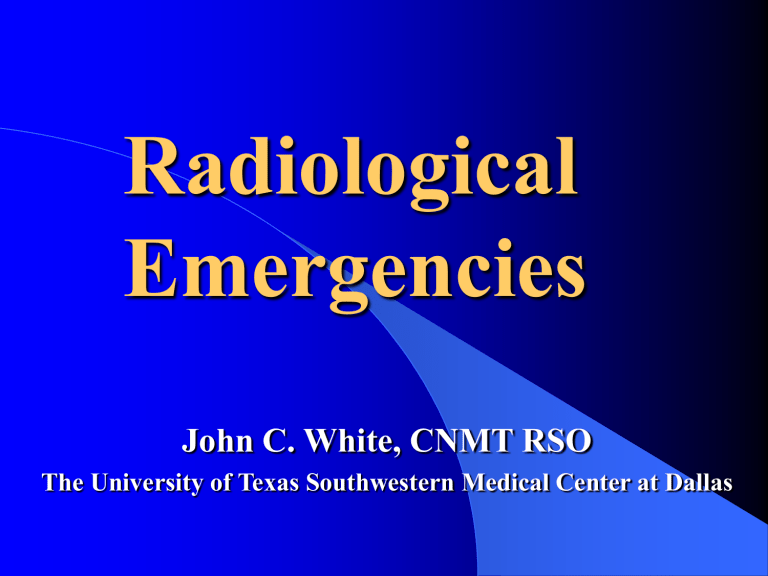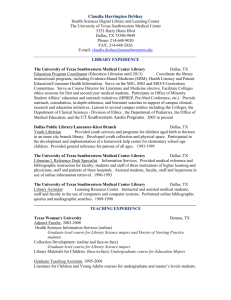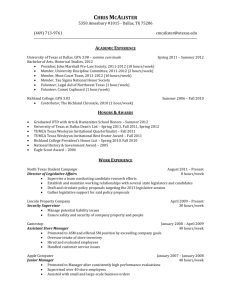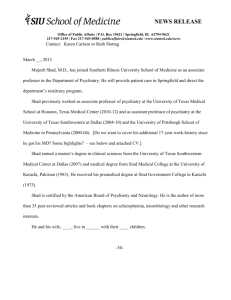Radiation Incident Response

Radiological
Emergencies
John C. White, CNMT RSO
The University of Texas Southwestern Medical Center at Dallas
Course Instructor
John C. White, CNMT, RSO
-Certified Nuclear Medicine Technologist
-Radiation Safety Officer
-President, Health Physics Society North and South Texas
-30 years experience with radioactives and radiation
-A/TC WMD Working Group
The University of Texas Southwestern Medical Center at Dallas 2
Introduction
This lesson will discuss:
Basic Radiation Principles
Perspectives on Risk
Radiological Incident Sources
Radiological Incident Response
The University of Texas Southwestern Medical Center at Dallas 3
Main Objectives:
To gain a better understanding about radiation and radioactivity
To provide an understanding of the harmful effects of radiation on the human body
How to safely respond to an emergency involving radioactive materials
The University of Texas Southwestern Medical Center at Dallas 4
Radiation and Risks
Radiation exposure
–
Radiation is everywhere and can be found in many forms
–
Some are very harmful to the human body
– Radiation injuries can take a long time to present. But when they do, it is usually in the form of cancer or birth defects
The University of Texas Southwestern Medical Center at Dallas 5
What Is Radiation ?
Energy
In the form of: Waves
Particles
…
Non-ionizing
Ionizing
6
Non-ionizing Radiation
Does Not Have Enough Energy to Remove
Electrons From Surrounding Atoms
Types of Radiation
Non-ionizing radiation
–
Waves of energy. Large wavelength
– Low frequency
Non-ionizing radiation comes from ultraviolet and infrared energy waves
*Note*:
– This type of radiation causes “sunburn” and is not a major concern for the hazmat responder
8
Energy Spectrum
The University of Texas Southwestern Medical Center at Dallas 9
Types of Radiation
Ionizing radiation
– Energy emitted in the form of electromagnetic waves or particles from the nucleus or electron cloud of an atom
Energy produced:
– Alpha particles
–
Beta particles
– Gamma or X rays
–
Neutrons
All of these sources may cause damage at the cellular level
The University of Texas Southwestern Medical Center at Dallas 10
Ionizing Radiation
Energy Can Be Deposited in Neighboring Atoms
Resulting in the Removal of Electrons.
alpha x-ray
High
Frequency
Small
Wavelength gamma ray neutron
beta
Alpha Radiation
Alpha radiation
– Alpha particles will travel 3 - 4 inches in air and cannot penetrate the outer layer of skin
–
Alpha particles can invade the body by other means, such as:
Injection
Inhalation
Ingestion
Absorption
The University of Texas Southwestern Medical Center at Dallas 12
Alpha Radiation
Not an external risk
Densely ionizing (internal exposure)
Easily shielded by skin, clothing, etc.
Internal risk
13
Beta Radiation
Beta radiation
–
Beta particles can travel 3 to 100 feet and may penetrate the skin.
* A firefighters gear can deflect beta particles
–
Personnel can be exposed through:
Inhalation
Ingestion
Injection
Absorption
Penetration
The University of Texas Southwestern Medical Center at Dallas 14
Beta Radiation
Can penetrate thin sheets of aluminum and skin
External skin hazard
Internal hazard, like alpha, through ingestion, inhalation or injection
15
Gamma Radiation
Gamma radiation.
– Gamma radiation is a naturally occurring or man-made high energy electromagnetic wave.
– It has a high penetrating power and can travel at the speed of light.
– Gamma rays will penetrate the skin and can cause injury to internal organs.
The University of Texas Southwestern Medical Center at Dallas 16
Gamma Radiation
Gamma Radiation Effects
–
Routes of entry into the body
Ingestion
Inhalation
Injection
Absorption
Penetration
The University of Texas Southwestern Medical Center at Dallas 17
Gamma Radiation
External and internal hazard
Best shielded with dense materials (e.g., lead or concrete)
Will easily penetrate Level A PPE
Easily detected
18
Neutron Radiation
High Speed Particle –
– No electrical charge
– Can travel hundreds of feet in air
– Can easily penetrate Level A PPE
– External hazard
– Best shielded w/materials that are hydrogen rich (elastic collisions)
The University of Texas Southwestern Medical Center at Dallas 19
RADIOLOGICAL HAZARD
ALPHA PARTICLE
Penetration capability of types of radiation
BETA PARTICLE
GAMMA RAYS
Neutron
The University of Texas Southwestern Medical Center at Dallas 20
Common Sources of Radiation
Radon - 55%
Other < 1%
Consumer Products - 3%
Nuclear Medicine - 4%
Rocks, Soil - 8%
Cosmic Rays - 8% X-rays - 11%
Water, Food - 11%
The University of Texas Southwestern Medical Center at Dallas 21
Definitions: (For Purposes of
Emergencies, R=RAD=REM)
Roentgen (R) (C/Kg)
–
A unit of exposure: the amount of ionizing radiation
(energy) produced in a specific volume of air
Radiation absorbed dose (RAD) (Gy)
–
A unit of absorbed dose: the amount of energy absorbed in a given volume of material.
Radiation equivalent in man (REM) (Sv)
– A unit of dose equivalent: the amount of radiation that has been absorbed times a quality factor
(biological effects)
22
Units of Measurement
2.58 x 10 -4 C /kg -1 = 1 R
1 R = 0.97 Rad (tissue)
0.97 Rad x 1 = 0.97 Rem
Therefore: 1R ~ 1 Rad ~ 1 Rem
1 R = 1000 mR (milliRem)
23
Definitions:
Activity
- the rate at which radioactive materials emit radiation
The number of nuclear disintegrations occurring in a given quantity of material per unit of time – usually referred to as dps or cpm
A curie (Ci) is the number of radioactive atoms that will decay and emit radiation in one second, not a function of weight of volume
The University of Texas Southwestern Medical Center at Dallas 24
International Units
-A Curie (Ci) is 37 billion disintegrations per second
3.7 x 10 10 dps = 1 curie (Ci) or 1000 millicuries
-A Becquerel (Bq) is 1 dps
1 Bq = 27 pCi = 0.000027
Ci
The University of Texas Southwestern Medical Center at Dallas 25
Definitions
Radioactivity
– Ionizing energy spontaneously emitted by a material or combination of materials.
Radioactive material
– One that spontaneously emits ionizing radiation
Radioactive contamination
–
Radioactive material in an unwanted place
– Internal / external
The University of Texas Southwestern Medical Center at Dallas 26
Units of Measurement
Curie
–
A unit of activity:
Milli-curie
–
One-thousandth of a curie
Micro-curie
–
One-millionth of a curie
The University of Texas Southwestern Medical Center at Dallas
.
27
Definitions:
Half-life
- The amount of time a radioactive material takes to decay to 1/2 of its original activity
Each radioactive material (Isotope = Source) has a unique half-life
– Sodium 25
–
Iodine 131
– Cobalt 60
–
Plutonium 239
60 seconds
8.04 days
5.27 years
24,139 years
After 7 half lives < 1% remains
The University of Texas Southwestern Medical Center at Dallas 28
Field Instrumentation
Identify hazards
Types of radiation
External
Magnitude
Identify affected media
Identify nuclide(s)
Offsite analysis (of media samples)
Field spectroscopy
May read in mR/hr or microrem/hr – know your meter!
29
Field Instrumentation
Alpha Detectors
– Alpha scintillators (zinc sulfide, ZnS)
– Air proportional detector
– Pancake G-M (Geiger Mueller)
Beta Detectors
– Pancake G-M
– Thin Wall G-M
Gamma Detectors
– Sodium Iodide (NaI)
– Geiger Mueller Tube,
Pancake G-M, Thin Wall G-M
The University of Texas Southwestern Medical Center at Dallas 30
Radiation Effects
Acute Exposure - Local or Total Body
Exposure occurs in hours or minutes
–
Repairable damage to cells
– Irrepairable damage to cells, but not causing death
–
Irrepairable damage resulting in death
The University of Texas Southwestern Medical Center at Dallas 31
Radiation Effects
Chronic Exposure
Small amounts of exposure over a long period of time
–
Birth defects of a Teratogenic or Mutagenic nature
The University of Texas Southwestern Medical Center at Dallas 32
Risk Perspective mrem/y
Avg. Background 360
Avg. Radiation Worker 400
Regulatory Limit
(Radiation Workers)
5,000
The University of Texas Southwestern Medical Center at Dallas 33
Health Risks
Radiation Risks
(bomb survivors)
Risk of developing a fatal cancer, non-fatal cancer, genetic effects, and length of life lost
0.0725 %/rem or 0.0000725 %/mrem
The University of Texas Southwestern Medical Center at Dallas 34
EPA Emergency Dose Limit
Guidelines
Dose Limit
(whole body)
5 rem
10 rem
25 rem
>25 rem
Emergency Action Dose Guidelines
Activity Performed
All activities
Protecting major property
Lifesaving or protection of large populations
Lifesaving or protection of large populations, only by volunteers who understand the risks.
The University of Texas Southwestern Medical Center at Dallas 35
Dose Limit Guidelines
The Maximum Lifetime exposure from a single incident is:
25 Rem
NCRP Report No. 138
50 Rem Whole Body , 500 Rem Skin
Justification, understanding risks
The University of Texas Southwestern Medical Center at Dallas 36
Types of Incidents
Los Alamos Wildfires Lost Sources
Three Mile
Island
Space Launches
Nuclear facility accidents
Nuclear weapon and device accidents
Nuclear terrorism
Satellite re-entry
Contaminated imports
Transportation accidents
Sabotage
Orphan sources*
Foreign incidents*
37
Potential Terrorist Incidents
Involving Radiation
The nature of these attacks (i.e., materials used, facilities involved, method of contamination, destructive intent) can vary greatly
– Assault or attack on power plants/nuclear facilities
– Improvised Nuclear Weapon/lost or stolen weapon
– Radiation Dispersal Device with or without explosives
– Radiation Exposure Device
– Water system contamination
– Purposely contaminated consumer products
– Orphan and lost sources
The University of Texas Southwestern Medical Center at Dallas 38
Obtainable Radiological Materials
Element
Cesium–137
Cobalt–60
Strontium-90
Iridium–192
Half Life
30 years
5.3 years
29.1 years
74 days
Type of Radiation
Beta, gamma
Beta, gamma
Beta, Bremsstrahlung (quantity)
Beta, gamma
Hydrogen-3
Plutonium-238
Plutonium-239
Americium – 241
Uranium-235, 238, DU
12.3 year
86 years
24,400 years
430 years
Beta (low energy)
Alpha (gamma contaminant)
Alpha, beta, gamma
Alpha, gamma
710M – 4.5B yrs.
Alpha, gamma (beta from daughters)
Medical and research isotopes:
Technetium-99m
Iodine – 131
Phosphorus-32
Gallium-67
Carbon-14
6 hours
8 days
14 days
78 hours
5730 years
Beta
Beta, gamma
Beta
Gamma
Beta 39
Radiation Dispersal
Device (RDD)
Terrorists pack a conventional explosive around radioactive material
– In the U.S., the sources would likely be radiography-type
(cesium, cobalt, iridium), which are fairly easy to detect if intelligence gives a general location
Terrorists purposely contaminate an area with radioactive materials through some aerosol spraying method
– Lethality is low
– Panic is high
Event is intended to panic the public and severely tax the resources of Federal and state government
– Many follow-up measurements would have to be made to assess the total contamination picture
– Even a small event may take years of study to understand
40
41
Source: Knight-Ridder Tribune
Characteristics of
Radiation Burn
Thermal Burn as Opposed to Radiation
Burn
- No sensation or recollection of immediate pain
Delayed Response
RDD as opposed to Atomic Blast
- Difference in Debris Field
- Flash
The University of Texas Southwestern Medical Center at Dallas 42
Radiation Exposure Device (RED)
Radioactive material that is intended to expose people in the vicinity of the device to emitted radiation
– RED could be a sealed source or a material within some type of container (e.g., a shoebox)
– The radioactive material could be in the form of a contained powder, a contained liquid, or a solid object
Example: if the radioactive material in an industrial radiography device is left without shielding, a person standing one meter from the source would have to stand at that location for about 5 hours to get a dose that would probably prove lethal (death within 2 months…)
The University of Texas Southwestern Medical Center at Dallas 43
Transportation
Accidents
WIPP transports
Industrial Radiography
Passenger / Air Cargo Flights
Rail Transport
The University of Texas Southwestern Medical Center at Dallas 44
Regulatory Agencies
The Department of transportation (DOT) serves as the regulatory agency involving radioactive materials if:
– A radioactive material having a specific activity of 70 Bq per gram (0.002 micro-curies per gram) of material
The DOT determines what type of packaging the material shall be encased and shipped in
ICAO/IATA determines types of packages acceptable on passenger/cargo aircraft
The University of Texas Southwestern Medical Center at Dallas 45
Emergency Response
Transportation Incidents
•
Radiation presents minimal risk
• Undamaged packages are safe. Contents of damaged packages may cause increased exposure or possible internal/external contamination
• Type A packages contain non-life endangering amounts
• Type B packages, and the rarely occurring Type C packages including [B(U)F, B(M)F, CF] contain the most
(potentially) hazardous amounts of material. Life threatening conditions may exist only if contents are released or package shielding fails or in utmost severity.
The University of Texas Southwestern Medical Center at Dallas 46
Emergency Response
Transportation Incidents
FIRE OR EXPLOSION involving Radioactive Material
• Some of these materials may burn, but most do not ignite readily.
• Radioactivity does not change flammability or other properties of materials.
• Type B packages (AF, IF, B(U)F, B(M)F and CF) are designed and evaluated to withstand total engulfment in flames at temperatures of 800°C (1475°F) for a period of 30 minutes.
The University of Texas Southwestern Medical Center at Dallas 47
Trigger Points
* Initial Alarm Level – 10 mR/h
* Turn Around – 10, 000 mR/h (10 R/h)
* Rule of Thumb
3000 - 4000 cpm = 1 mR/h
The University of Texas Southwestern Medical Center at Dallas 48
Radiation ‘Experts’
Radiation Safety Officer
USNRC
State – TxDSHS
Nuclear Medicine Professionals
FEMA
EPA
USDOE
Several Other Federal Agencies
Health Physics Society
The University of Texas Southwestern Medical Center at Dallas 49
What to Look for in an
‘Expert’
Familiar with Instruments
Practical Advice
Ability to Calculate
Credential
Familiarity with Contamination
The University of Texas Southwestern Medical Center at Dallas 50
Emergency Response
Transportation Incidents
•
Stay upwind.
• CALL Emergency Response Telephone Number on Shipping
Paper first.
• Priorities for rescue, life-saving, first aid, and control of fire and other hazards are first.
• Keep unauthorized personnel away.
• Detain or isolate uninjured persons or equipment suspected to be contaminated; delay decontamination and cleanup until instructions are received from Radiation Authority.
The University of Texas Southwestern Medical Center at Dallas 51
Emergency Response
Transportation Incidents
• Radiation Authority must be notified of accident conditions.
Radiation Authority is usually responsible for decisions about radiological consequences and closure of emergencies.
• Isolate spill or leak area immediately for at least 25 to 50 meters (80 to 160 feet) in all directions.
The University of Texas Southwestern Medical Center at Dallas 52
Emergency Response
Transportation Incidents
Shipping papers and labels indicate the level of
“ activity ”
The type of transportation container (A, B or C) is determined by the Ci content and level of exposure
The University of Texas Southwestern Medical Center at Dallas 53
Example
Radioactive Material
–
Shall be packaged, at a minimum, in a
Cardboard Box. This is called “Type A
package”.
The University of Texas Southwestern Medical Center at Dallas 54
Radiation Labels
HAZARD
CATEGORY
CONTENTS
ACTIVITY
Contents Cs-137
Activity 37 GBq (1.0 Ci)
2.0
TRANSPORT INDEX
TRANSPORT
INDEX
HAZARD CLASS
The University of Texas Southwestern Medical Center at Dallas 56
Radioactive Labels
Radioactive White - I
–
One vertical red stripe
– Low level hazard (activity)
–
Surface radiation level,maximum of 0.5 mR/hr
Radioactive Yellow - II
– Two vertical red stripes
–
Moderate hazard (activity)
– Surface radiation level, maximum of 50 mR/hr
–
1 mR/hr maximum at one meter from package
The University of Texas Southwestern Medical Center at Dallas 57
Radioactive Labels
Radioactive Yellow III
– Three vertical red stripes
–
Highest level hazard (activity)
–
Surface radiation level – maximum of 200 mR/hr
–
10 mR/hr maximum at one meter from the package
EXCLUSIVE USE
– 1000 mR/h on package surface,
200 mR/h outer surface vehicle, 10 mR/h at 2 meters
The University of Texas Southwestern Medical Center at Dallas 58
Transport Index
A number placed on the label to designate the degree of control to be exercised during transport
TI is the maximum radiation level in mR/hr per hour) at 1 meter from package
If TI is 2, the maximum radiation level at 1 meter would be 2 mR/hr
59
NFPA Objective 4-2.1.4
The University of Texas Southwestern Medical Center at Dallas
Placards
Placards are only required to be displayed on vehicles for
Type III shipments
The University of Texas Southwestern Medical Center at Dallas 60
Radioactive Container
Shapes
Protective overpacks
–
Cylindrical configuration
–
Boxlike configuration
Casks
–
Rigid metal packaging
–
Reinforcing rings and cooling fins
The University of Texas Southwestern Medical Center at Dallas 61
Radioactive Container Shapes
Type A
Fiberboard
Wooden
Boxes
Steel Drums
Type B Package
Designed to meet standards for performance under hypothetical accident conditions
Tests Conducted
– Dropped from a height of 30 feet
–
Dropped on a steel spike from 40 inches
– Exposed to fire at 1,475 0 F for 30 minutes
The University of Texas Southwestern Medical Center at Dallas 63
Radioactive Cask
Type B
Type B Package
TRUPACT I and II
Certified by NRC
Meets USDOT safety requirements
TRUPACT I will hold 7 - 55 gallon drums
TRUPACT II will hold 14 - 55 gallon drums
Weight
– 12,700 lbs
–
19,250 lbs
The University of Texas Southwestern Medical Center at Dallas 65
Trupact I
Trupact II
The University of Texas Southwestern Medical Center at Dallas 66
Emergency Response
When responding to a radiological emergency, personnel MUST remember three (3) important characteristics:
We Cannot Smell it
We Cannot Taste it
We Cannot See It
Rushing in to a radiological emergency spells trouble!!
The University of Texas Southwestern Medical Center at Dallas 67
Emergency Response
Personnel Safety
–
Responders shall ensure the safety of themselves and co-workers, prior to performing rescues or evacuations of victims or potential victims.
This can be done by performing a proper
size up of the scene prior to commitment of personnel.
The University of Texas Southwestern Medical Center at Dallas 68
Emergency Response
Identifying Material
– Labels
–
Placards
– Bill of Lading
– Shipper’s Declaration
69
Documents
70
Emergency Response
Other information may come from:
–
An operator of a transport vehicle
–
User
–
Manufacturer
–
Shipper
The University of Texas Southwestern Medical Center at Dallas 71
Emergency Response
Monitoring
–
Monitoring should begin prior to arriving at the scene.
Radioactivity can be monitored by:
CD V-700
CD V-715
–
The CD V-700 survey meter has a range of 0 to 50 mR/Hour.
The University of Texas Southwestern Medical Center at Dallas 72
Performing a Rescue
In situations involving rescue, certain safety requirements must be considered and include:
Knowing the characteristics of radiation
Ensuring personnel safety
Who should perform rescue
Who should perform evacuation
The University of Texas Southwestern Medical Center at Dallas 73
Emergency Response
Protection
– Protection can be achieved by:
Time
Distance
Shielding
–
All of these should be in-place when working a Radiological Emergency
The University of Texas Southwestern Medical Center at Dallas 74
Fire, Spill or Leak
-See ERG
Small Fires
Dry chemical, CO 2, water spray or regular foam.
Large Fires
Water spray, fog (flooding amounts).
SPILL OR LEAK
Do not touch damaged packages or spilled material.
Damp surfaces on undamaged or slightly damaged packages are seldom an indication of packaging failure. Most packaging for liquid content have inner containers and/or inner absorbent materials. If any radioactive contamination resulting from a liquid release is present, it probably will be low-level.
The University of Texas Southwestern Medical Center at Dallas 75
Protection Factors
Time
– the shorter the exposure time, the less the exposure
– Radiation exposures are additive in their effects upon the or any other subject
The University of Texas Southwestern Medical Center at Dallas 76
PROTECTION FACTORS
Distance
– the closer you are, the greater the exposure
– the energy emitted from a radioactive source declines as you move away from the source
The University of Texas Southwestern Medical Center at Dallas 77
EXERCISE
1. There is a wreck on I-20, on approach you recognize it as semi transporting a type B cask. The cask as it appears, has not cracked open. You determine that the TI is 10.
If you stand at 3 ft away from the cask for one hour, what is your exposure?
2. On further examination it appears the cask has been cracked, someone standing next to you measures 0.5 R/hr and you have been there for 30 minutes. What dose did you receive?
The University of Texas Southwestern Medical Center at Dallas 78
Inverse Square Law
If you double the distance from the source, the intensity is lowered by one fourth
Inverse Square Law - The intensity of ionizing radiation declines with the square of the distance
Protection Factor Formula = Distance 2
Quantity
Distance 2
= Amount of Radiation Received
The University of Texas Southwestern Medical Center at Dallas 79
Protection Factor
5 ft.
10 ft.
20 ft.
30 ft.
1000 mR/hr 40 mR/hr 10 mR/hr 2.5 m/hr 1.1 mR/hr
5 X 5 = 25
1000
= 40 mR/hr
25
10 mR/hr
4.4 mR/hr
30 X 30 = 900
1000
= 1.1 mR/hr
900
The University of Texas Southwestern Medical Center at Dallas 80
EXERCISE
You are at the scene of transport accident and find that on measurement you are standing in a 500 mR/h field which is one meter (3 ft) away from the source of radiation.
How far would you have to move away from the source to be less than an initial alert level of 10 mR/h?
The University of Texas Southwestern Medical Center at Dallas 81
PROTECTION FACTORS
Shielding
–
Personnel protective equipment can offer protection against alpha particles
– PPE will offer limited protection against beta particles
–
PPE offers NO protection against gamma radiation
Positive pressure self-contained breathing apparatus (SCBA) and structural firefighters’ protective clothing will provide adequate protection against internal radiation exposure, but not all external radiation exposures.
The University of Texas Southwestern Medical Center at Dallas 82
Emergency Care
• Medical problems take priority over radiological concerns.
• Use first aid treatment according to the nature of the injury
• Do not delay care and transport of a seriously injured person.
• Apply artificial respiration if victim is not breathing. Administer oxygen if breathing is difficult.
• In case of contact with substance, immediately flush skin or eyes with running water for at least 20 minutes.
• Injured persons contaminated by contact with released material are not a serious hazard to health care personnel, equipment or facilities.
• Ensure that medical personnel are aware of the material(s) involved, take precautions to protect themselves and prevent spread of contamination
83
This Presentation
Was Developed by the
North Texas Chapter
Health Physics Society
-The Radiation Safety Professionals
-In Conjunction with
The University of Texas Southwestern
Medical Center at Dallas
The University of Texas Southwestern Medical Center at Dallas 84




